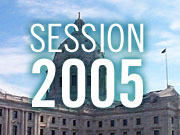May 19, 2005
 |
| Despite shrinking resources, all-day kindergarten remains a budget priority of Monroe Community School in St. Paul. (MPR Photo/Tim Pugmire) |
St. Paul, Minn. — The office at Monroe Community School in St. Paul can be a busy place for one secretary. The school serves nearly 500 students in kindergarten through eighth grade.
Robin Trierweiler spends her day answering phones and fielding questions from teachers, students and parents. She's also in charge of attendance forms, enrollment records, school files and the mail.
"Back when I first started here, we had five girls that worked in this office doing the job that I'm doing," Trierweiler said. "It is very hard to do. It's crazy. You get behind. It's hard to take time off, because when you do you come back to the piles of work. Just every day is a challenge."
Lots of challenges have been piling up for St. Paul schools. Over the last five years, the district-wide budget cuts have totaled $50 million. State funding hasn't kept pace with rising operational costs, and declining enrollment has reduced the funding levels.
At Monroe, they've cut back on office staff, librarians, reading instructors and other assistants. During the winter, thermostats were turned down to 68 degrees. Principal Jim Eaton says he's worked hard to keep most of the cuts far away from students.
"We actually try to have what the students would notice minimized," Eaton said. "So they'll see their teacher. They'll see the materials that they need to do their job in front of them. But some of the supports that they might have or some of the additional help that they might have, they won't see that."
The strategy appears to be working. Sixth grader Kayelle Woods hasn't noticed any changes in her school. She's attended Monroe since since the first grade and is still learning.
"This is the only school that really fits me, and has really done a good job to teach me a lot of things," Woods said.
One of the programs Jim Eaton has fought to protect is all-day kindergarten, which is only partially funded by the state. About 80 percent of Monroe students live in poverty, and they show up for kindergarten with a wide range of abilities.
Teacher Kathy Olson works hard to increase the reading skills of her 19 students. She said an all-day program helps close the early learning gaps.
"We keep a lot of records. We do a lot of assessments to see where they need to go, where they are until they meet standards, what they need work on," Olson said. "When we get newcomers in that haven't had the rich literacy background, it's hard to catch up. We've been working all year on some of this."
It's getting harder to fund all-day kindergarten and preserve small class sizes in St. Paul. The district is preparing for another round of cuts even if it gets an increase in state funding. At Monroe, they're expecting 56 fewer students next year. Jim Eaton said that translates into a cut of five classroom teachers.
"I can sit down with the budget, we can start eliminating things, but there's a face attached to every one of those items that I'm reducing," Eaton said. "Because when you're educating kids, it's very people-intensive. It's not thing-intensive. I'm not getting rid of this set of computers. I'm not getting rid of this process for doing things. We're eliminating people."
Eaton says every staff reduction he's forced to make results in an increased workload for the remaining classroom teachers. He says dedicated educators willingly accept those added responsibilities for the sake of their students. But Eaton wonders how long it will be before those heaping plates begin to overflow.
At the Capitol, House and Senate leaders insist their competing education bills will begin to provide the kind of relief schools like Monroe have been waiting for.






